Sharks: Part 2
Issue date: 14th July 2021
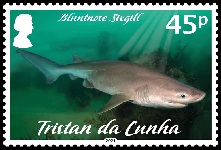 |
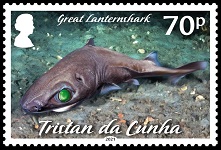 |
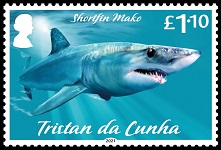 |
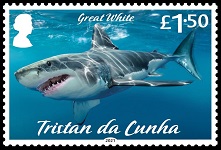 |
| 202105 | Mint Stamps (45p, 70p, £1.10, £1.50) | £3.75 |
| 202106 | First Day Cover (with 45p, 70p, £1.10, £1.50 stamps) | £4.95 |
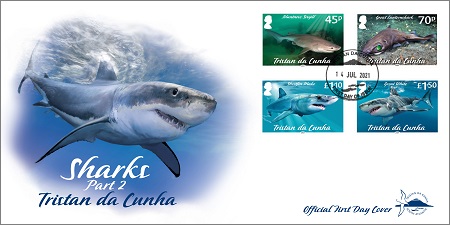
Description
45p - Bluntnose Sixgilled Shark (Hexanchus griseus)
The Bluntnose Sixgill shark is the largest of the hexanchoid sharks growing to 20 ft (6m) in length and is often called cow shark. It is of ancient lineage, with more of its closest relatives being fossil sharks from the Triassic period than living today. It is found in tropical and temperate waters worldwide. This stout shark with six-gill slits has a short blunt snout, a broadly rounded mouth and its single dorsal fin is set far back near the caudal fin. It has small green eyes and broad comb-like teeth, brown to dark grey above fading to greyish-white on its belly, and its fins have thin white trailing edges. Adults generally stay deeper than 330ft (100m), while juveniles can often be found in shallower water. The diet of Bluntnose Sixgill sharks varies widely with region, feeding on a wide range of marine species, including other sharks, rays, chimaeras, bony fish, squids, crabs, shrimps, carrion and even seals. Although they have been reported as being sluggish in nature, their body structure enables them to reach remarkable speeds for chasing and effectively capturing prey. They are probably nocturnal hunters, and are usually seen near the surface only at night. In 1989 an immature male was caught at Gough Island. Bluntnose Sixgill sharks were seen on 30% of camera drops from 190-1027m by the National Geographic Pristine Seas expedition to Tristan in 2017. This species is listed as Near Threatened on the IUCN Red List.
70p - Great Lanternshark (Etmopterus princeps)
Lanternsharks are a difficult to identify species, and one caught at Inaccessible in 1993 by Capt. E. Stoffberg, of the MV Hekla, was provisionally identified as Great Lanternshark (Etmopterus princeps). This is a relatively small deepwater shark of the family Etmopterida and is normally found in the North and Eastern Central Atlantic. This species of shark is small and stout, growing up to 30 in (75cm), and is uniformly dark blackish brown. It has a moderately long, broad tail and long gill slits. The dorsal fins have an associated spine but it lacks an anal fin. Great Lanternsharks can be found in waters over 4000 m deep, but they typically swim between 300 to over 2000 m deep. Lanternsharks (Etmopterus - not identified to species level) were seen on 56% of camera drops from 714-1404m by the National Geographic Pristine Seas expedition to Tristan in 2017. Listed as Least Concern very little is known about the life and habits of this deepwater shark.
£1.10 - Shortfin Mako (Isurus oxyrinchus)
The world's fastest shark, the Shortfin Mako shark (Isurus oxyrinchus), commonly referred to as the mako shark, blue pointer or bonito shark, is a large mackerel shark, which can reach a size of 13ft (4 m) in length. It can be found worldwide in tropical and temperate waters, both inshore and in the open ocean. It is cylindrical in shape, with a vertically elongated tail. This species exhibits countershading, with brilliant metallic blue coloration dorsally and white ventrally, which helps to camouflage it from both above and below in the open ocean. The shortfin mako is highly migratory and is known to travel long distances. It inhabits depths from the surface down to 490ft (150m) feeding mainly upon cephalopods and bony fish including mackerels, tunas, bonitos, and swordfish, but it may also eat other sharks, porpoises, sea turtles, and seabirds. Makos are said to be common in Tristan waters, although seldom landed; they are occasionally seen leaping from the water, and are known to display aggressive behaviour towards boats. The National Geographic Pristine Seas expedition in 2017 tagged a Shortfin mako shark, and another was tagged by the Tristan Fisheries and Conservation Departments. Mako sharks are globally endangered due to their being heavily targeted for their fins.
£1.50 - Great White Shark (Carcharodon carcharias)
The Great White shark (Carcharodon carcharias) is the largest predatory fish in the world, occurring worldwide in tropical and temperate seas. It has an extremely muscular body, capable of chasing down some of the fastest swimmers in the ocean. Reaching lengths of up to 20 feet (6 m) and weights of several tons, the great white's body is perfectly adapted to a life of predation. It has a conical snout, pitch black eyes, a heavy, torpedo-shaped body, and a crescent-shaped, nearly equal-lobed tail fin that is supported on each side by a keel. The great white swims in a stiff-bodied, tuna-like fashion, unlike the sinuous whole-bodied swimming stroke of most sharks. As they grow, they can take larger prey, and the largest, mature individuals prefer to eat marine mammals, like seals and sea lions. Great whites are known to take very deep dives, probably to feed on slow-moving fishes and squids in the cold waters of the deep sea. They are known to be highly migratory, with some individuals making migrations as long as 12,000 miles (20,000 km) in under a year. A 16ft (4.9 m) long great white shark was caught at Gough Island in a depth of 51 m on July 1, 1993 by Captain Ben Herwig and Mike Saunders of the MFV Tristania II According to Captain Herwig, the stomach of this shark contained seals and 7 "bluefish" [Hyperoglyphe antarctica]. The Great White is listed as Vulnerable with its two biggest threats being overfishing and being accidentally caught in fishing nets.
FDC - Great White Shark (Carcharodon carcharias)
Technical Specifications from Pobjoy Mint Ltd.
| Designer: | Andrew Robinson | ||
| Printer: | Cartor | Stamp size: | 42 x 28mm |
| Process: | Stochastic Lithography | Perforation: | 13¼ x 13½ per 2cms |
| Production Co-ordination: | Creative Direction (Worldwide) Ltd | Sheet format: | 10 |
